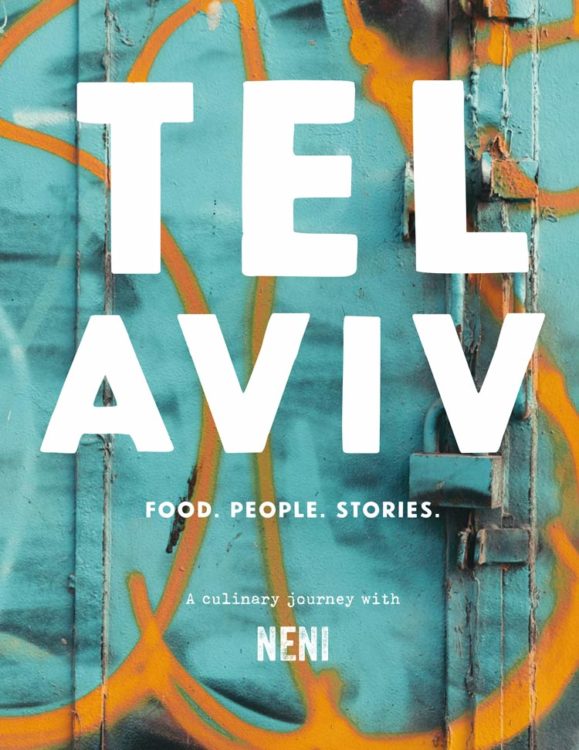An expertly crafted composition of what the vibrant, ancient, and contemporary city has to offer.
From the bustling streets of Israel to the contemporary dining experiences of Europe, the Molcho family integrated both of these elements to create a truly superb cookbook. Originally from Tel Aviv, Haya Molcho moved to Europe and created her restaurant, NENI, which is the first letter of each of her son’s names. It was a family effort to create the cookbook; including a trip to their motherland.
The 150 recipes were gathered from locals who are both chefs and storytellers. Each section of the book is divided like many other cookbooks: condiments, vegetables, seafood, meat, and sweets. The difference with Tel Aviv is that the book has intermittent stories from the people that live there, whether they’re chefs, stall owners, or local restaurateurs.
The book itself is perfect for that bustling kitchen environment. Its bulk shouldn’t deter you from what’s within, as it stays open perfectly on the page being viewed. The text is large enough to view from where you keep it propped out of the way of the mixing bowl and the preparation of ingredients, and it’s safe to say that the flour can easily be blown off the pages, along with wiping off that smear of butter!
I wanted to make everything from this cookbook, but time was unfortunately not on my side. Nevertheless, I decided on three recipes which I knew would be crowd-pleasers.
Kubbeh Hamo (page 226)
This recipe was provided by Elran Shrefler, owner and chef of Azura in Tel Aviv. The restaurant began in Jerusalem, and to this day, much like NENI, is family owned and run. Kubbeh Hamo is a savoury dish normally shared between six people but for my own purposes, the recipe was halved.
All of the ingredients were easy to source at local supermarkets, and the only one which gave some grief was the bulgar. After some Googling, I discovered that bulgar, and bulghur were, in fact, the same thing. I was unfortunately unable to locate a fine version of the grain (as specified) and instead opted for the regular grain. In hindsight, I believe this made a big difference to the dough. The recipe suggests that if the dough is too sticky, flour should be added, but while in the process of cooking, more and more flour was being added and the consistency didn’t seem to change. Regardless, the dough was easy to mould once it had rested for a while and was also easy to cook.
The filling for the dumpling-like balls was easy to make as well, along with the soup which the dumplings cook in. The conclusion: the recipe was easy to make – save for the dough trauma – but I’d put that down to the ingredient which was purchased, not the ingredient which was stated in the recipe itself.

Challa (page 253)
Another passionate contributor to the cookbook, Aner Zalel, is the baker/philosopher/owner of Dallal Bakery in the trendy Neve Tzedek neighbourhood of Tel Aviv. Like all good bakeries, a signature bread is a must. The challa, or at least, an interpretation of the challa, is found in many cultures. The Greeks have the Tsoureki which is a very similar recipe, and most surrounding Mediterranean and Middle Eastern countries would have something the same yet different again. This was so easy to make. Like the previous recipe this one was also halved, so only one was made. All of the ingredients were easy to access, especially because I already had all of them at home. The result was very true to the recipe, and not a single ingredient or method was changed.

Orange French Toast with Almond Cream (page 257)
The best thing about this recipe, was that I’d already made one of the key ingredients. The base of this sweet treat was the base of the extremely versatile challa. Like the previous recipes, this one was also halved to suit our needs, which turned out to still be plenty of food. This recipe is appropriate for a sweet breakfast, brunch, lunch, or dessert.
For the orange syrup, the Grand Marnier was substituted for freshly squeezed orange juice – which was also suggested by Haya in an alternative helpful tip. Likewise, for the almond cream, the almond extract was substituted for vanilla extract. As the dish is topped with almonds, the flavour of them was not lost, and the added vanilla flavour worked extremely well.

Tel Aviv is an expertly crafted composition of what the vibrant, ancient, and contemporary city has to offer. The recipes were easy to follow, the skills needed were not advanced and it was easy to manage when juggling different aspects of the recipe. Once everything was completed, the outcomes were delicious.
Reviewed by Phoebe Christofi
Twitter: @ChristofiPhoebe
Distributed by: Murdoch Books
Released: March 2019
RRP: $49.99






















